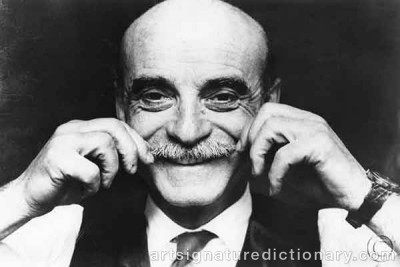
Lucio FONTANA
1899–1968, Argentina/Italy
Also known as: LF
Biography
Discover the life and artistic journey of Lucio FONTANA (born 1899, 19/2, Argentina, died 1968, 7/9, Italy), including key biographical details that provide essential context for signature authentication and artwork verification. Understanding an artist's background, artistic periods, and career timeline is crucial for distinguishing authentic signatures from forgeries.
Lucio Fontana was born February 19, 1899, in Rosario de Santa Fé, Argentina. His father was Italian and his mother Argentinean. He lived in Milan from 1905 to 1922 and then moved back to Argentina, where he worked as a sculptor in his father’s studio for several years before opening his own. In 1926, he participated in the first exhibition of Nexus, a group of young Argentinean artists working in Rosario de Santa Fé. Upon his return to Milan in 1928, Fontana enrolled at the Accademia di Belle Arti di Brera, which he attended for two years.
The Galleria Il Milione, Milan, organized Fontana’s first solo exhibition in 1930. In 1934, he joined the group of abstract Italian sculptors associated with Galleria Il Milione. The artist traveled to Paris in 1935 and joined the Abstraction-Création group. The same year, he developed his skills in ceramics in Albisola, Italy, and later at the Sèvres factory, near Paris. In 1939, he joined the Corrente, a Milan group of expressionist artists. He also intensified his lifelong collaboration with architects during this period.
In 1940, Fontana moved to Buenos Aires. With some of his students, he founded in 1946 the Academia de Altamira from which emerged the Manifiesto Blanco group. He moved back to Milan in 1947 and in collaboration with a group of writers and philosophers signed the Primo manifesto dello spazialismo. He subsequently resumed his ceramic work in Albisola to explore these new ideas with his Concetti spaziali.
The year 1949 marked a turning point in Fontana’s career; he concurrently created the Buchi, his first series of paintings in which he punctured the canvas, and his first spatial environment, a combination of shapeless sculptures, fluorescent paintings, and black lights to be viewed in a dark room. The latter work soon led him to employ neon tubing in ceiling decoration. In the early 1950s, he participated in the Italian Art Informel [more] exhibitions. During this decade, he explored working with various effects, such as slashing and perforating, in both painting and sculpture. The artist visited New York in 1961 during a show of his work at the Martha Jackson Gallery. In 1966, he designed opera sets and costumes for La Scala, Milan.
In the last year of his career, Fontana became increasingly interested in the staging of his work in the many exhibitions that honored him worldwide, as well as in the idea of purity achieved in his last white canvases. These concerns were prominent at the 1966 Venice Biennale, for which he designed the environment for his work, and at the 1968 Documenta in Kassel. Fontana died September 7, 1968, in Comabbio, Italy.
Lucio Fontano var en italiensk målare, grafiker och skulptör. Fontana var en djärvt experimenterande konstnär, som använde många olika material och tekniker som gips, cement och keramik i stora blockformer. Från 1940-talet sökte han nya uttrycksmedel som fritt hängande konstruktioner. Hans senare måleri är dock det som mest har uppmärksammats – hans engagemang i rymden och rummet. Hans spatiala kompositioner ”Concetto Spatiale” på en helt monokrom yta, som med knivskarpa snitt, ett eller flera, har öppnats för kontakt med den yttre och inre rymden. Där upphäver de positiva och negativa faktorerna varandra och förintar materien, medan gravitationshålen är så snabba att inget ljus hinner nå dit.
Source: https://www.bukowskis.com
Explore other artists
Discover other notable artists who were contemporaries of Lucio FONTANA. These artists worked during the same period, offering valuable insights into artistic movements, signature styles, and authentication practices. Exploring related artists makes it easier to recognize common characteristics and artistic conventions of their era.